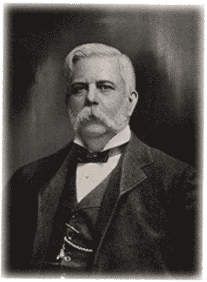George Westinghouse was an inventor and entrepreneur who created a series of "fixes" that enhanced railroad industry function and safety.
Early Life
 George Westinghouse was born in 1846 in Central Bridge, New York, west of Albany. He served in both the Union army and navy during the Civil War. He received his education at Union College and the University of Schenectady.
George Westinghouse was born in 1846 in Central Bridge, New York, west of Albany. He served in both the Union army and navy during the Civil War. He received his education at Union College and the University of Schenectady.
The Inventions Begin
Westinghouse perfected the first of his long list of successful inventions with the development of a “railway frog” or “reversible frog” which enabled trains to be placed on tracks.
The safety record of the early American railroad industry was dismal. Steam engines exploded, trains rammed into one another or derailed, all with depressing regularity. As a response to one of these problems, Westinghouse in 1868 developed the air brake, providing a reliable way of stopping a train.
The Westinghouse Air Brake Company was formed the following year. This invention was slowly adopted by many railroads in the United States, but it became mandatory equipment with the passage of the Railway Safety Appliance Act in 1893. The air brake also became popular in Europe and Westinghouse became a leader in the effort to standardize parts, enabling them to be used throughout the world.
Addressing another safety concern, George Westinghouse invented an automatic railroad signal device which employed both electricity and compressed air. In 1882, the Union Switch and Signal Company was formed.
Other Accomplishments
George Westinghouse also became a leader in the introduction of alternating current transmission technology to the United States. Initial service had been provided by direct current, whose proponents bitterly resisted any change. The famed inventor Nikola Tesla was employed by Westinghouse to develop motors. Westinghouse’s triumph came when he won a contract to install alternating current generators at Niagara Falls.
Empire Lost But Legacy Lives On
During the Depression which followed the Panic of 1907, George Westinghouse suffered huge financial losses and terminated his relationship with his companies. But the legacy of his inventions, such as the air brake, live on in modern trains today.